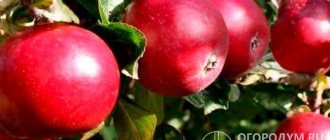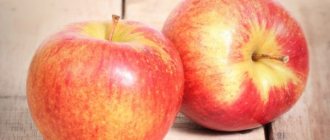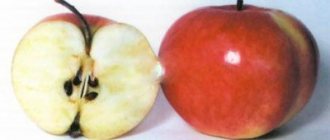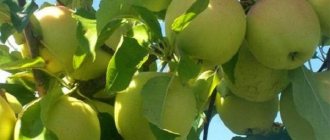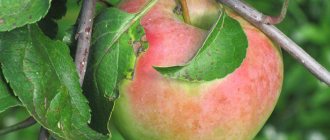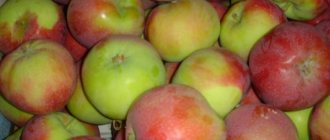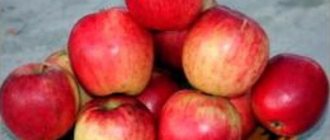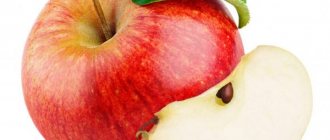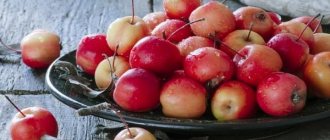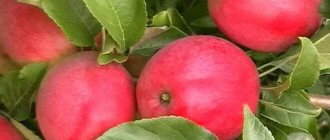Description of the Cortland apple tree
The Cortland apple tree has a rather tall, smooth trunk with brown and brown bark. The crown of the tree has a spreading and voluminous appearance, more reminiscent of a circle. Straight tree shoots of average length, the color of ripe cherry, with slight pubescence.
The leaf blade is short with a distinct tip, covered with veins and grooves. Leaf color is not uniform:
- the upper part is painted in light green tones;
- the lower part of the leaf blade has a more whitish tint.
The flower stalks of the tree are not very large, painted white with a slight shade of pink haze. For the Cortland apple tree, the characteristic features of peduncles are the formation of group inflorescences (from 6 to 9 pieces) in mid-May - early June. The delicate honey aroma of flower stalks attracts a large number of bees.
The first fruits of the Cortland apple tree will have to wait only 6 years after planting the seedling. But, if the seedling was purchased on a medium-sized rootstock MM-106, then the timing of fruiting shifts significantly. It will be possible to get a harvest from such trees 4 years after planting.
From the photo you can make a detailed description of Cortland apples:
The fruits of the Cortland apple tree have a rounded-flattened shape. Based on their appearance and maximum weight of 140 g, they can be classified as medium-sized. The peel of apples is thin and smooth, with a slight bluish waxy coating.
The color of the fruit changes depending on the degree of ripening:
- Green color with slightly visible gray is characteristic of the initial stage of ripening.
- The appearance of a lemon-yellow color with the presence of a waxy coating indicates that the fruits have reached the middle stage of maturity.
- Clear strokes of red shades without a waxy coating appear on a lemon-yellow background - the fruits have reached final ripening.
The stalk is small in size with a large depression. The seeds, which are large and brown in color, are located in wide seed chambers.
The flesh is white in color and has a subtle pink tint to the skin. The structure of the pulp is compacted and very juicy.
Cortland apples: description
Swarm of Bees Honey Plants Apple Tree
The late variety of Cortland apples was first obtained in a scientific laboratory in New York in 1898 by crossing two species - McIntosh and Ben Davis. It has become widespread, including in Russia, since 1915. The variety is zoned in the Lower Volga region and is included in the state register of breeding achievements.
The Cortland apple was developed in 1898.
Characteristic
The trees of these apple trees are vigorous, have a spreading, voluminous round crown. The trunk is covered with brownish-gray and smooth bark, the shoots are of medium size, very dark cherry in color, pubescent, straight. The surface of young shoots is covered with many small lentils. The buds are conical in shape, pubescent, appressed, and medium in size. The short, pointed leaves have pronounced veins and grooves, light green above and whitish below. There are no stipules, the leaf blade is flat, with a large-crowned edge, and densely pubescent. Small petioles of medium length and diameter, pubescent.
The inflorescence usually consists of 5–6 small flowers, sometimes more, up to 9 pieces. From the pinkish buds appear small saucer-shaped flowers with white, open petals; there is no terry. The anthers are located higher than the anthers.
The Cortland apple tree bears fruit 5 or 6 years after planting, the yield is good, towards the end of autumn.
Apples are standard sizes, weighing 90–130 g, slightly elongated, streamlined in shape with a thin, delicate peel covered with a smoky coating. The size and shape of the fruit is uniform, the color is yellow-green with blurry red stripes and a purple blush at final ripening.
Cortland fruits taste very juicy
Rules of care
In the description of the Cortland apple tree variety, it is worth noting its ability for rapid growth and longevity. There are specimens that are 70 or more years old. In addition, if they are not pruned, the height of such a tree can reach 5 meters or more. The crown will acquire a span of 4 to 6 m. It is not advisable to grow a tree of this size, because it will be very difficult to collect the rich harvest that it is capable of producing. For this reason, regular pruning of the tree is necessary.
The Cortland tree needs periodic pruning
Landing
The description of planting Cortland apple trees includes soil preparation and selection of high-quality seedlings, the optimal planting age of which is 1–2 years. One-year-old trees do not have developed branches; 2-year-old trees have 3–4 branches growing to the side at a right angle or 45o.
Before the planned planting of an apple tree, the soil is dug up in advance, loosened, freed from weeds, fertilized, and dug up again. This should be done several months before planting the trees. At the same time, a hole is prepared, deep and wide. Depending on the climate of the region, apple trees can be planted both in spring and autumn. Experienced agronomists recommend doing this in April, when the soil has already warmed up a little. Advantages of the variety:
- long shelf life of fruits;
- high consumer qualities;
- frost resistance;
- suitability for any type of processing.
The disadvantages of the Cortland variety are susceptibility to diseases such as powdery mildew and scab, which reduce its yield.
Taste qualities of Cortland apple variety
The tasting rating of the fruits of the Cortland apple tree is 4.5 points out of 5 possible. Confirmation of this fact can be found in numerous reviews from gardeners who have long and successfully grown the Cortland variety in their garden plots.
Cortland apples have a sweet and sour taste and an unusual fragrant aroma, and are distinguished by their versatility:
- fresh consumption;
- processing into juice, cider, vinegar;
- preparation of dried fruits;
- making jams and marmalade.
Reviews
Ekaterina Platonovna, Ukraine: “We have Cortland apples, the description of which we saw by chance. And now the tree has been growing here for more than 20 years. Although there are not many apples, like other winter varieties, I really like their taste. And what I like even more is that there is practically no complicated care for the plant.”
Matvey, Belarus: “The apples are delicious, they last a long time, you can make jams and compotes from them. The apple tree is already quite old, it will soon not bear fruit, we want to plant the same one, only undersized. They say fruit tastes even better on it.”
Anastasia, Russia: “We have been growing apple trees for more than 10 years. Very tasty fruits, sweet and sour, crispy. And the main thing is that they remain the same until spring.”
Pros and cons of the variety
A description of the Cortland apple tree variety cannot be called complete without indicating its advantages and disadvantages.
The main positive characteristics of the Cortland apple tree:
- regular fruiting;
- high taste qualities;
- long period of storage of fruits without loss of taste;
- versatility of use;
- decorativeness of an adult tree.
The most common disadvantages of this variety are its average winter hardiness and susceptibility to fungal diseases such as powdery mildew and scab.
The appearance of fungal diseases on the apple tree can be avoided by taking timely preventive measures.
Important! It is strictly prohibited to treat trees during the flowering period!
Main characteristics
Among the main characteristics there are features of the fruit, the tree itself and fruiting, which should be known and taken into account.
Cortland apple tree.
Tree size
An adult tree is of medium height, reaching 6 m in height. The crown is wide and round, grows quite quickly and needs regular pruning.
Fruit evaluation
The fruits are yellow-green when ripe and covered with a purplish-red blush. The taste of the pulp is sweet and sour, and it emits a persistent aroma. The tasting score is 4.7 points.
Winter hardiness
The resistance to low temperatures of the Cortland variety is characterized as moderate. This means that the apple tree can tolerate low temperatures, but only with good immunity and additional protection.
Disease resistance
The immunity of the Cortland apple tree is quite high. However, during periods of favorable conditions for fungal diseases, they may appear on the apple tree. Therefore, for prevention, annual spring spraying will be required. Correct implementation of agrotechnical procedures will also provide protection.
Sooty fungus.
If infection does occur, then it is necessary to immediately proceed to treatment. Most often, the fungus appears during high humidity, provided there is sufficient temperature. Fungicidal drugs are used for treatment.
Frequency of fruiting
The Cortland apple tree bears fruit annually. Even if the tree has survived a severe frost, it will quickly resume life and bear fruit. However, this is only possible by planting pollinators nearby.
Productivity
The variety's yield indicators are average. From one mature healthy tree, about 25 kg of mature fruits can be removed per season.
Optimal growing conditions
For growing Cortland apple trees, the optimal conditions will be choosing a suitable location on the site and, most importantly, the region of future growth.
The Cortland apple tree has average winter hardiness, so growing it in risky farming regions would be absolutely unacceptable. The Cortland apple tree will grow and develop well in the regions of the Lower Volga region, the Caucasus, the Republic of Crimea and the Donbass. It is possible to plant and grow Cortland apple trees in Belarus and the Baltic countries, but only on standard trees.
History of creation
The Cortland apple tree was bred in 1898 in the USA by hybridizing the Ben Bevis and McIntosh varieties. It has become widespread in Europe. Since 1915, Cortland has been cultivated in Russia.
This variety is included in the State Register of Breeding Achievements, zoned in the Lower Volga region , including the Volgograd, Kursk, and Saratov regions, and is grown in eastern Ukraine. It has prospects for cultivation on standard-forming plants in Belarus and the Baltic republics.
Planting and caring for a Cortland apple tree
Proper agricultural technology and proper care of the Cortland apple tree will allow you to obtain a harvest of ripe and juicy apples.
This calendar will help gardeners create the best care for seedlings and mature Cortland apple trees.
Selection and preparation of a landing site
The issue of choosing and preparing a site for planting a Cortland apple tree must be approached thoroughly.
The apple tree prefers sunny areas with fertile, breathable, loamy or sandy soil. The moisture capacity of the soil is also an important criterion, but prolonged stagnation of melt water or the location of underground ground rivers closer than 2 m to the surface can lead to the death of the tree.
If the planting site is dominated by depleted or heavy soils, then it will be necessary to carry out additional work to enrich the soil by preparing a nutrient substrate. To prepare it you will need:
- the top fertile layer of soil dug out from the future planting hole;
- sand;
- humus or high peat;
- superphosphate (0.25 kg);
- wood ash (0.3 kg).
All components must be thoroughly mixed, after which the resulting nutrient substrate can be used to plant a Cortland apple tree seedling.
Preparation of the selected area must be carried out in advance. Several months before the planned planting, a number of preparatory works are carried out:
- Digging the soil.
- Loosening.
- Removal of weeds.
- Fertilizer application.
After all the steps have been completed, the soil must be dug up again, after which the planting hole is prepared.
Important! When planting seedlings in spring, it is better to dig a hole in the fall.
If it was not possible to prepare it in the fall, then the planting hole is prepared 2 weeks before the planned planting.
Seedling preparation
Before you begin preparing a seedling, you must purchase it. The best choice would be to buy one- or two-year-old Cortland apple tree seedlings.
Important! It is best to purchase seedlings from certified fruit nurseries; this will reduce the risk of purchasing a diseased or weak bush.
Before planting a seedling, it is necessary to carefully inspect the root system. If there are damaged skeletal roots, they will need to be pruned. If the root system has overly branched roots, they will need to be trimmed by 15 cm.
For better contact with the soil, the roots must be dipped into the mash solution. It is prepared in equal parts from clay and mullein. This treatment of the root system will significantly speed up the survival time of the Cortland apple tree seedling.
Landing rules
Cortland apple trees are planted in early spring or autumn. But many years of experience of gardeners and agronomists shows that better development can only be achieved by planting a Cortland apple tree seedling in the spring.
When planting, it is necessary to take into account the structure and fertility of the soil.
| Soil type | Planting hole size (cm) | Adding nutrient substrate | Reduced filtration |
| Fertile | 70x70x70 | — | — |
| Heavy clay | 100x100x100 | Necessary | — |
| Sandy | 100x100x100 | Necessary | The bottom is covered with clay to a depth of 15 cm. |
If you plan to plant several seedlings, then there should be a distance of up to 5 m between them. The Cortland apple tree can grow and develop for at least 70 years, which is why the distance between seedlings is so important.
The technology for properly planting a seedling includes the following steps:
- Preparing the planting hole.
- Adding nutrient substrate in the amount of 1/3 of the total volume of the planting pit.
- Digging in the support trunk.
- Vertical placement of the seedling in the hole with mandatory leveling of the root system.
- Filling the top layer of soil.
- Compacting the planting.
- Charging watering in the amount of 3 buckets of water per seedling.
- Mulching the tree trunk circle.
Important! If the grafting site is located 5-7 cm above the ground level, then the seedling was planted correctly.
Watering and fertilizing
During the first years of the growing season, an apple tree seedling must be watered every 2 weeks, and in the event of a dry summer, when starting to prepare the tree for winter, it is necessary to carry out water-recharging watering in September. To do this, you need to pour 30 liters of water into the tree trunk circle for each year of plant development, for example, if 3 years have passed since planting, then you will need 90 liters of water per tree.
The amount of fertilizer required for better development of a tree in different years of life is indicated in more detail in the table.
| One year after landing | Diameter of the trunk circle (m) | Manure or compost (kg) | Urea (kg) | Superphosphate (kg) | Potassium sulfate (kg) |
| 1-2 | 2 | 15-20 | 0,03 | 0,12 | 0,04 |
| 3-4 | 2,5 | 20-25 | 0,045 | 0,18 | 0,06 |
| 5-6 | 3 | 30-40 | 0,065 | 0,27 | 0,09 |
| 7-8 | 3,5 | 40-50 | 0,09 | 0,36 | 0,12 |
| 9-10 | 4 | 40-50 | 0,14 | 0,48 | 0,15 |
| 11-12 | 5 | 80 | 0,18 | 0,75 | 0,24 |
When the tree is over 13 years old, fertilization will correspond to the bottom line of the table.
Trimming
The Cortland apple tree requires pruning, which should be done every year. This must be done not only in old trees, but also in young ones.
There are 4 types of tree pruning:
- Formative. This pruning is carried out on 5-year-old trees in order to form a crown of the correct shape and increase its illumination.
- Sanitary. Trimming damaged and improperly growing branches.
- Regulatory. It inhibits the tree's upward growth and deprives the crown of shading branches.
- Rejuvenating. Old apple trees need this type of pruning. It will increase the yield.
The photo clearly demonstrates the rules for pruning the Cortland apple tree in different years of the growing season:
Another, but very important factor is that when carrying out any type of apple tree pruning, the air temperature should become stable, and the thermometer should not fall below + 10 °C.
Preparing for winter
In order for the apple tree to successfully overwinter, it is necessary to prepare the tree for wintering already at the end of September or at the beginning of October.
A dry mixture of superphosphate and potassium should be added to the tree trunk circle. For 1 m2 you will need 30 g of potassium and 50 g of superphosphate. The mixture is scattered a little further from the tree trunk, then the soil must be dug up onto the bayonet of a shovel. After this, water-charging irrigation is carried out.
While the leaves have not fallen, it is necessary to treat the trees with urea. To prepare the solution, you will need to dilute 0.5 kg of fertilizer in a bucket of water. Wood treatment is carried out by leaf spraying. This will reduce the risk of fungal diseases and the likelihood of spider mites appearing in the spring.
Do not forget about whitewashing trees, as it protects the bark of the apple tree from sudden changes in temperature, bright sun, cold wind and frost. Whitewashing can also protect the bark from attacks by insect pests and from the teeth of mice and hares.
For whitewashing, you can dilute 400 g of lime and 100 g of copper sulfate in 10 liters of water. The surface of the apple tree trunk is carefully treated with the resulting solution.
Features of care
How the apple tree will look and bear fruit will depend on the quality and timely care, which consists of watering, nutrition with organic and mineral products, pruning, weeding and protection from pests.
Watering
Watering plays an important role in the development of apple trees. In the first year of growth, it is recommended to water it every two weeks, using at least 25–30 liters of water per seedling. If the summer is too dry, moistening should be done every week.
A sufficient amount of moisture especially needs to be taken care of during the flowering period of the crop, during the fruit formation phase and after harvesting.
It should be noted that the apple tree has a negative attitude towards both prolonged drought, which can cause the leaves and ovaries to dry out, and excessive humidity, which can lead to rotting of the root system.
Important! Determining the rate of watering a plant is quite simple - you need to pour out 30 liters of water for each year of tree growth. For example, a one-year-old seedling requires 30 liters of water, and a three-year-old seedling needs 90 liters.
Rules for pruning and crown formation
To maintain good immunity and stable yields, the apple tree should be pruned annually, and measures should be taken to form the crown. For a tree with 1–2 years of life, the shoots should be shortened by 1/3, thus forming the main conductor.
Such formative pruning is carried out until the tree reaches five years of age, while:
- The circumcision procedure is performed in early spring at temperatures not lower than +10°C;
- the lower branches are shortened to 30 cm vertically;
- young shoots that grow in relation to the central conductor at an angle of 90° are completely cut off.
Every year, sanitary or rejuvenating (for old trees) pruning is carried out, during which dry, old, damaged shoots with diseases are removed. A correctly carried out procedure allows you to stimulate the growth of young shoots, activate the full development of the tree and increase its productivity.
Fertilizers and rates of their application
For Cortland to grow fully, he should organize high-quality feeding using organic preparations and minerals.
Fertilizers can be applied 3-4 times per season:
- the first fertilizing using urea is carried out immediately after wintering;
- the second time the culture is fed before the flowering phase, for this a mixture of 10 liters of water, 40 g of superphosphate, 25 g of potassium and 50 g of urea is used;
- at the end of flowering, add a third portion of fertilizer - a solution of nitrophoska;
- Before preparing the plant for winter, the soil around the tree trunk is fertilized with humus and wood ash.
Did you know? The largest apple in the world was grown by Japanese agronomist Chisato Iwasagi in 2005. The weight of the fetus after weighing it was a little more than 2 kg.
Preparing for winter
The Cortland apple tree is characterized by good winter hardiness, however, in order for it to successfully overwinter, it is better to take care of its protection.
Preparatory work should begin in the fall:
- At the end of September and beginning of October, the soil around the tree trunk is dug up and loosened.
- A mixture of 50 g of superphosphate and 30 g of potassium is added to the soil.
- The soil around the trunk is moistened abundantly.
A few weeks later, the trunk is whitewashed, which will protect the tree from insects and rodents. A few weeks before the expected frost, the plant trunk is wrapped in natural, breathable material. After snow appears, you can form a snowdrift about 1 m high around the tree.
Diseases and pests
With all the advantages of the Cortland apple tree, it cannot boast of 100% resistance to fungal infections and attacks by insect pests. Most often, the Cortland apple tree variety is affected by scab and powdery mildew.
To prevent the appearance of scab, it is necessary to perform a number of measures:
- Application of potassium-phosphorus fertilizers.
- Autumn cleaning of carrion and leaves.
- Autumn processing of bark by stripping and whitewashing.
- Autumn treatment with solutions of copper sulfate and urea.
- Spring treatment with Bordeaux mixture.
To prevent and treat apple trees from powdery mildew, the gardener needs to treat with fungicide solutions during the periods before and after flowering:
- Bordeaux mixture;
- chorus;
- speed
You can fight insect pests using acaricidal drugs:
- Aktara;
- Talstar;
- Inta-Vir;
- Karbofos;
- Kinmiks.
Treatment with any preparations should be carried out in dry, windless weather in the morning or evening, observing all safety measures when working.
Cortland apple tree: advantages and disadvantages
Cortland apples: photo of variety
Like any other plant and crop, the Cortland apple tree has its advantages and disadvantages, which you should definitely know. The advantages of the variety include:
- High level of taste characteristics.
- Fruiting on a regular basis.
- The ability to store apples for a long time without losing their taste characteristics.
- In adulthood, this apple tree has high decorative properties.
- Fruits of universal use.
The disadvantages of the Cortland apple tree variety include an average level of frost tolerance, as well as a predisposition to fungal diseases, such as scab and powdery mildew. Although it is possible to prevent the occurrence of fungal diseases on this tree, thanks to timely preventive actions. But it is worth noting that in no case should these plants be treated during flowering.
Reviews of the Cortland apple tree
Vilkova Anastasia Olegovna, 38 years old, Lugansk
The Cortland apple tree was planted 12 years ago, and when purchasing a seedling, the seller simply persuaded us to take this particular variety. For several years in a row, my husband and I had thoughts of simply cutting down a tree. Only in the 3rd year of its life the tree gave us 2 apples. But what a surprise we were when there were more fruits on the tree, and the taste of apples was difficult to replace with some other variety. 8 years after planting, the tree began to bear fruit annually and consistently. If gardeners still want to buy a new variety of apple tree, then I definitely recommend purchasing Cortland. The only thing you need to do is be patient, and the result will exceed all expectations.
Karpukhin Mikhail Vladimirovich, 46 years old, Volgograd
My summer cottage is located in close proximity to the river and any variety of apple trees that I planted died after 4 years. A friend recommended the Cortland variety. To my surprise, this particular variety turned out to be the most durable on my site. Trying the first fruits of the apple tree caused me simply indescribable delight - the sweet and sour taste and extraordinary aroma simply made me fall in love with this apple tree. And when the price of fruit is high in winter, I have no need to purchase market apples - mine are perfectly stored in the basement until April. I recommend this variety to gardeners, because, in my opinion, it is quite promising, and tree care is minimal.
Cortland apple tree on a low-growing rootstock
Caring for and harvesting tall apple trees is difficult. The optimal solution may be to plant trees on a low-growing rootstock - dwarf or semi-dwarf. They have a number of advantages:
- The height of the tree does not exceed 3 m;
- Earlier fruiting - in the second or third year;
- Compact planting saves space in the garden;
- It is allowed to plant seedlings on soils with close groundwater;
- The fruits are larger and tastier than those of vigorous apple trees.
Classification of apple tree clonal rootstocks according to growth vigor.
Dwarf trees bear fruit well for 18-25 years, after which the yield drops. This disadvantage is compensated by stable fruiting and higher productivity than that of tall apple trees.
Cortland apple tree: description of the variety and characteristics, history and yield with photos
Korobovka (Medunichka, Skorospelka)
Winter variety, obtained at the New York Experimental Station in 1898 (distributed since 1915) as a result of crossing the Ben Davis and Mekintosh varieties. It was included in the State Register for the Saratov and Volgograd regions.
Trees
vigorous. The crown is round or spreading. The bark on the trunk is smooth, gray-brown. Fruiting is concentrated on ringlets, spears and fruit twigs.
Escapes
medium, straight, rounded in cross-section, dark brown, almost black, heavily pubescent. There are a lot of lentils, of medium size. The buds are appressed, small, conical, pubescent. The leaves are medium-sized, ovate, short-pointed, green, wrinkled, matte, with rough nerves. There are no stipules. The leaf blade is flat, heavily pubescent, the leaf margin is large-crowned. The petiole is of medium length and thickness, pubescent. The flowers are of medium size, saucer-shaped, the petals are white, practically not closed, entire, without a claw or terry, the stigmas of the pistils are below the anthers. The buds are pink. The inflorescence contains 6-9 (average 6) flowers.
Fruit
medium (96-135 g), round-conical, uniform in size and shape.
The skin of the fruit is thin, tender, smooth, with a coating. The integumentary coloring throughout the fruit is in the form of red stripes, turning into a blurred blush. The main color is greenish-gray, yellow when ripe. The fruits
are covered with a bluish-purple coating. The stalk has a green color, which does not disappear when the fruit ripens. When the fruits are fully ripe, the main color becomes yellow, and the outer color becomes bright red. In this case, the bluish coating from the surface of the fruit disappears. The peduncle is short, strong, thin, often with irregular projections; the recess of the stalk is large, cone-shaped, with wide grooves, often rusty. The calyx is small, closed or semi-open; sepals are short, narrow and pointed; the upper fossa is pubescent, small, narrow, with steep walls, smooth or vaguely grooved. The subcalyx tube is short, conical, the heart is off-axis, the seed chambers are wide and open. The seeds are brown, large, pointed. The pulp is white, with a reddish tint at the edge, dense, fine-grained, tender, juicy, with a rich, pleasant, specific taste. It begins to bear fruit in 5-6 years. Productivity is average.
Advantages of the variety:
long shelf life, high taste and attractive appearance of the fruit.
Disadvantages of the variety:
susceptibility to powdery mildew, average resistance to scab and average winter hardiness.
Regions in which this variety of Apple tree, Cortland, reveals all its fruiting abilities to the maximum
